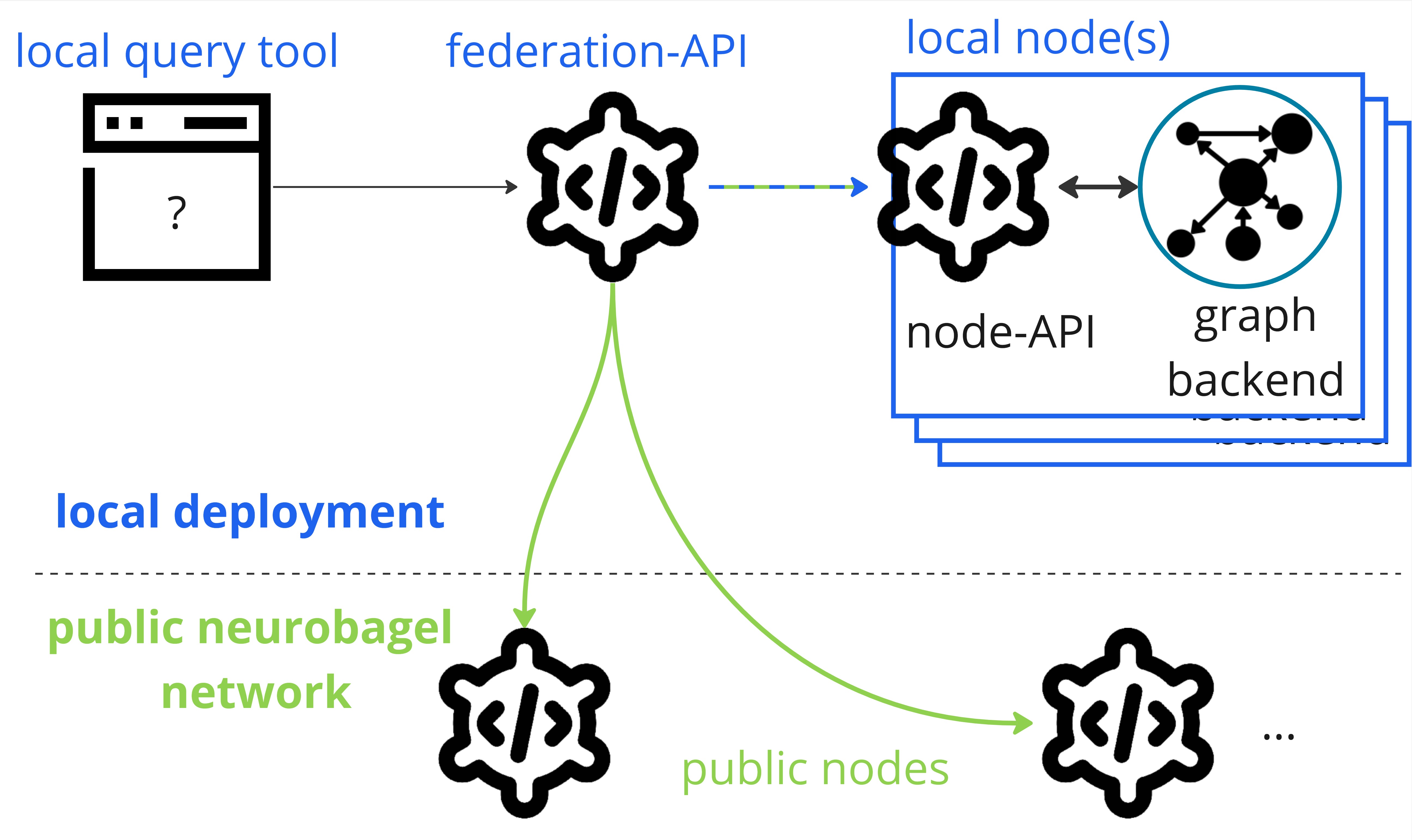Getting started
The following sections will get you started with deploying your own Neurobagel node, a graphical query tool, and a local federation API (everything in blue in the picture below) that lets you search across the data in your node and in public Neurobagel nodes.

To prepare your Neurobagel node for production use (i.e., for local or other users), and to configure your deployment according to your specific needs, refer to the detailed Configuration documentation.
Requirements
Neurobagel tools are provided as Docker containers and are launched with Docker Compose.
Don't install Neurobagel tools directly on your machine
Please only use the docker images provided by Neurobagel
(or the third party providers Neurobagel relies on) and only launch
them with our provided docker-compose.yml recipe.
Do not install GraphDB locally on your computer, as doing so can interfere with the deployment of the Neurobagel tools.
docker and docker compose
If you haven't yet, please install both docker and docker compose
for your operating system:
-
Install Docker Desktop on Windows. This will install both
dockeranddocker compose. -
We strongly recommend also installing Windows Subsystem for Linux to get a Windows-supported Linux installation for a more seamless Neurobagel deployment experience. Simply follow these instructions to make your existing Docker Desktop installation (including Docker and Docker Compose) available when running WSL.
Install Docker Desktop on Mac.
This will install both docker and docker compose automatically.
Linux is the only supported OS
We test and deploy on Linux and ensure that our deployment instructions work on Linux systems.
We also try to provide docs and help for different architectures, but as a small team with limited resources we won't be able to help you debug Operating System specific problems.
Because we rely on some modern features of these tools, please make sure you have at least the following versions on your machine:
dockerengine: v20.10.24 or greaterdocker --versiondocker compose: v2.0.0 or abovedocker compose version
The Neurobagel node deployment recipe
The neurobagel/recipes repository
on GitHub contains our official
Docker Compose recipe and template configuration files for setting up a local Neurobagel node.
- Clone the GitHub repository to your machine and navigate to it
git clone https://github.com/neurobagel/recipes.git cd recipes - Make copies of the template configuration files to edit for your deployment (do not edit the templates themselves)
cp template.env .env cp local_nb_nodes.template.json local_nb_nodes.json -
Change
NB_API_QUERY_URLin the.envfileYou must replace the placeholder value for
NB_API_QUERY_URLin the.envfilewith the address of the machine you are going to deploy Neurobagel on.NB_API_QUERY_URL=http://XX.XX.XX.XX- If you are deploying Neurobagel for yourself or just to try things out locally,
you can use:
NB_API_QUERY_URL=http://localhost:8080where:8080is the default port for the federation API. - If you are deploying Neurobagel on a server for other users, you must use the IP (and Port) or URL that your users will access the server with.
- If you are deploying Neurobagel for yourself or just to try things out locally,
you can use:
Info
This is the minimal configuration you need to make before you can launch Neurobagel. In most cases, and especially when you are deploying Neurobagel for other users, you will have to make additional configurations.
Please refer to our detailed documentation for a complete overview of configuration options.
Launch Neurobagel
Once you have edited the .env and optionally the local_nb_nodes.json file,
you can launch your own Neurobagel node with the following docker compose command:
docker compose --profile full_stack up -d
this will:
- pull the required Docker images (if you haven't pulled them before)
- launch the containers for the Neurobagel services using the
full_stackservice profile - automatically set up and configure the services based on your configuration files
- automatically upload data to the Neurobagel graph (by default, it will upload an example dataset we have provided for testing)
You can check that your docker containers have launched correctly by running:
docker ps
❯ docker ps
CONTAINER ID IMAGE COMMAND CREATED STATUS PORTS NAMES
d5e43f9ff0c2 neurobagel/federation_api:latest "/bin/sh -c 'uvicorn…" 8 seconds ago Up 8 seconds 0.0.0.0:8080->8000/tcp, :::8080->8000/tcp recipes-federation-1
f0a26d0ea574 neurobagel/api:latest "/usr/src/api_entryp…" 8 seconds ago Up 8 seconds 0.0.0.0:8000->8000/tcp, :::8000->8000/tcp recipes-api-1
d44d0b7359c8 ontotext/graphdb:10.3.1 "/usr/src/neurobagel…" 8 seconds ago Up 8 seconds 0.0.0.0:7200->7200/tcp, :::7200->7200/tcp, 7300/tcp recipes-graph-1
29a61a2d83de neurobagel/query_tool:latest "/bin/sh -c 'npm run…" 8 seconds ago Up 8 seconds 0.0.0.0:3000->5173/tcp, :::3000->5173/tcp recipes-query_federation-1
The docker-compose.yml recipe provides additional service profiles
for different deployment use cases (e.g., if you do not need to set up local query federation). Please refer to
our service profile documentation for details.
Next steps

- Try the Neurobagel node you just deployed by accessing:
- your own query tool at http://localhost:3000 and reading the query tool guide
- the interactive API docs at http://localhost:8000/docs and reading the API guides
- Prepare your own dataset for annotation with Neurobagel
- Add your own data to your Neurobagel graph to search
- Learn about the different configuration options for your Neurobagel node
- Hopefully all went well, but if you are experiencing issues take a look at our getting help guide